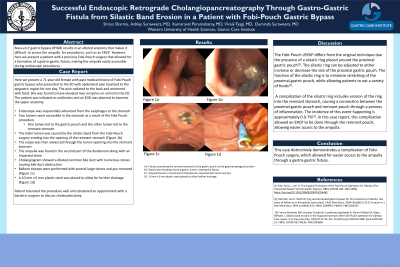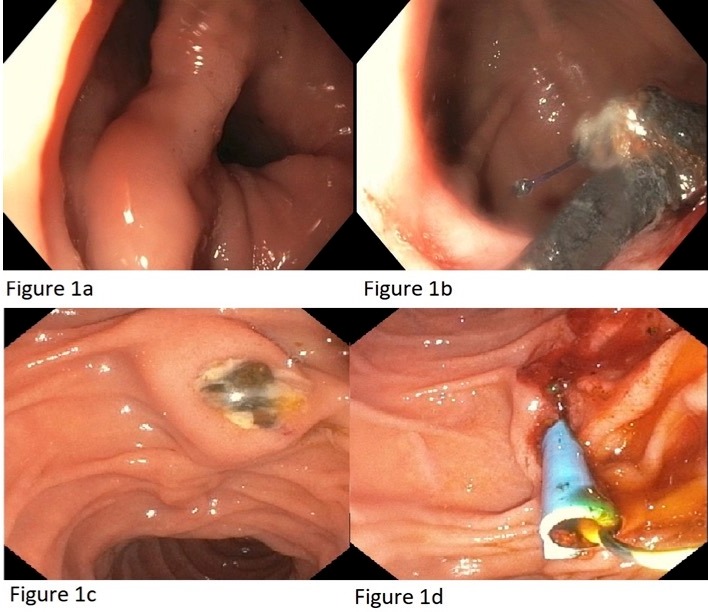Monday Poster Session
Category: Interventional Endoscopy
P2316 - Successful Endoscopic Retrograde Cholangiopancreatography Through Gastro-Gastric Fistula from Silastic Band Erosion in a Patient with Fobi-Pouch Gastric Bypass
Monday, October 23, 2023
10:30 AM - 4:15 PM PT
Location: Exhibit Hall

Has Audio
- SS
Shriya Sharma, BS
Western University of Health Sciences
Pomona, California
Presenting Author(s)
Shriya Sharma, BS1, Ashley Suraweera, MD2, Duminda Suraweera, MD3, Kumaravel Perumalsamy, MD3, Vivaik Tyagi, MD3
1Western University of Health Sciences, Pomona, CA; 2UCLA Health, Los Angeles, CA; 3Gastro Care Institute, Lancaster, CA
Introduction: Roux-en-Y gastric bypass (RYGB) results in altered anatomy that makes conventional endoscopic retrograde cholangiopancreatography (ERCP) difficult. Here we present a patient with a previous Fobi-Pouch RYGB that was able to successfully undergo conventional ERCP due to a complication from her prior surgery.
Case Description/Methods: A 71-year-old female with a history of Fobi-Pouch RYGB presented to the emergency department with abdominal pain localized to the epigastric region for one day. She was noted to have a fever to 38.2 Celsius with other vitals being normal. Labs were notable for a leukocytosis and abnormal liver function tests. Magnetic resonance cholangiopancreatography (MRCP) showed a dilated common bile duct to 21mm with multiple choledocholithiasis. Patient was started on antibiotics for cholangitis. Due to the emergent nature an endoscopy was promptly performed to confirm anatomy and access to ampulla to allow for ERCP decompression of bile duct. Patient was noted to have a fistula connecting the remnant stomach to the gastric pouch at the gastroesophageal junction (Figure 1a). Further examination revealed that the silastic band used in the Forbi-Pouch technique had eroded into the gastric lumen likely creating the fistula (Figure 1b). An ERCP endoscope was introduced through the fistula into the remnant stomach. The ampulla was subsequently found to be in the second part of the duodenum with an impacted stone and copious amounts of pus (Figure 1c). Cholangiogram showed a dilated common bile duct with numerous stones. Balloon sweeps were done with several large stones and pus removed. A 10 mm x 6 mm plastic stent was placed to allow further drainage (Figure 1d). The patient tolerated the procedure well. Her fevers, leukocytosis and abdominal pain resolved by the next day with significant improvement in her liver function tests. Patient was discharged on day three of hospitalization with follow up scheduled for stent removal and further evaluation with bariatric surgery
Discussion: The Fobi-Pouch RYGB differs from the original technique due the presence of a silastic ring placed around the proximal gastric pouch. The function of the silastic ring is to minimize stretching of the proximal gastric pouch. A complication of the silastic ring is erosion of the ring into the stomach. The incidence of this event happening is approximately 0.9-7%. In this case report, this complication allowed an ERCP to be done through the remnant stomach, allowing prompt access to the ampulla.

Disclosures:
Shriya Sharma, BS1, Ashley Suraweera, MD2, Duminda Suraweera, MD3, Kumaravel Perumalsamy, MD3, Vivaik Tyagi, MD3. P2316 - Successful Endoscopic Retrograde Cholangiopancreatography Through Gastro-Gastric Fistula from Silastic Band Erosion in a Patient with Fobi-Pouch Gastric Bypass, ACG 2023 Annual Scientific Meeting Abstracts. Vancouver, BC, Canada: American College of Gastroenterology.
1Western University of Health Sciences, Pomona, CA; 2UCLA Health, Los Angeles, CA; 3Gastro Care Institute, Lancaster, CA
Introduction: Roux-en-Y gastric bypass (RYGB) results in altered anatomy that makes conventional endoscopic retrograde cholangiopancreatography (ERCP) difficult. Here we present a patient with a previous Fobi-Pouch RYGB that was able to successfully undergo conventional ERCP due to a complication from her prior surgery.
Case Description/Methods: A 71-year-old female with a history of Fobi-Pouch RYGB presented to the emergency department with abdominal pain localized to the epigastric region for one day. She was noted to have a fever to 38.2 Celsius with other vitals being normal. Labs were notable for a leukocytosis and abnormal liver function tests. Magnetic resonance cholangiopancreatography (MRCP) showed a dilated common bile duct to 21mm with multiple choledocholithiasis. Patient was started on antibiotics for cholangitis. Due to the emergent nature an endoscopy was promptly performed to confirm anatomy and access to ampulla to allow for ERCP decompression of bile duct. Patient was noted to have a fistula connecting the remnant stomach to the gastric pouch at the gastroesophageal junction (Figure 1a). Further examination revealed that the silastic band used in the Forbi-Pouch technique had eroded into the gastric lumen likely creating the fistula (Figure 1b). An ERCP endoscope was introduced through the fistula into the remnant stomach. The ampulla was subsequently found to be in the second part of the duodenum with an impacted stone and copious amounts of pus (Figure 1c). Cholangiogram showed a dilated common bile duct with numerous stones. Balloon sweeps were done with several large stones and pus removed. A 10 mm x 6 mm plastic stent was placed to allow further drainage (Figure 1d). The patient tolerated the procedure well. Her fevers, leukocytosis and abdominal pain resolved by the next day with significant improvement in her liver function tests. Patient was discharged on day three of hospitalization with follow up scheduled for stent removal and further evaluation with bariatric surgery
Discussion: The Fobi-Pouch RYGB differs from the original technique due the presence of a silastic ring placed around the proximal gastric pouch. The function of the silastic ring is to minimize stretching of the proximal gastric pouch. A complication of the silastic ring is erosion of the ring into the stomach. The incidence of this event happening is approximately 0.9-7%. In this case report, this complication allowed an ERCP to be done through the remnant stomach, allowing prompt access to the ampulla.

Figure: 1A: Fistula connecting the remnant stomach to the gastric pouch at the gastroesophageal junction
1B: Silastic band eroding into the gastric lumen creating the fistula
1C: Ampulla found in second part of duodenum impacted with stone and pus
1D: 10 mm x 6 mm plastic stent placed to allow further drainage
1B: Silastic band eroding into the gastric lumen creating the fistula
1C: Ampulla found in second part of duodenum impacted with stone and pus
1D: 10 mm x 6 mm plastic stent placed to allow further drainage
Disclosures:
Shriya Sharma indicated no relevant financial relationships.
Ashley Suraweera indicated no relevant financial relationships.
Duminda Suraweera indicated no relevant financial relationships.
Kumaravel Perumalsamy indicated no relevant financial relationships.
Vivaik Tyagi indicated no relevant financial relationships.
Shriya Sharma, BS1, Ashley Suraweera, MD2, Duminda Suraweera, MD3, Kumaravel Perumalsamy, MD3, Vivaik Tyagi, MD3. P2316 - Successful Endoscopic Retrograde Cholangiopancreatography Through Gastro-Gastric Fistula from Silastic Band Erosion in a Patient with Fobi-Pouch Gastric Bypass, ACG 2023 Annual Scientific Meeting Abstracts. Vancouver, BC, Canada: American College of Gastroenterology.
